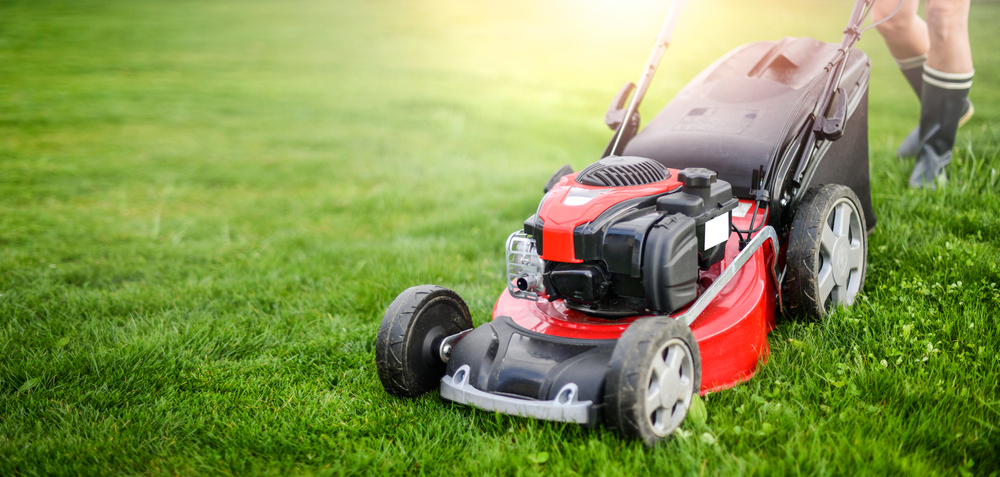Lawn care can be challenging in the midwest. Summers can be scorching hot. Winters can be more frigid than expected. So it’s difficult to determine when the best time for the first mow of the spring should happen.
No snow!
Well, first, wait till there’s no more snow. At all. All the snow on your property should be melted, and not just on the lawns. That’s an indicator that the snow won’t be back till winter. Here’s what to look for:
- Snow should be gone from the lawns.
- The soil should be slightly springy when you step on it.
- The temperature should be at least 40° F during the day consistently for a couple of weeks.
- The lawns should look well-watered but not wet. It’s a fine distinction. Wet grass cuttings can clump up and damage the lawn. The clumps can also stick to the inside of the mower, where it’s hard to scrape out. And you can slip on wet grass and hurt yourself while the mower is running.
- The blades of grass should be standing up straight. This means the grass has recovered from the weight of the snow.
- The grass should be at least three inches tall.
Three inches tall? After the snow, sometimes it’s not more than two inches tall by then. It seems like forever for it to grow long enough, but if you mow while it’s too short, you’ll be pulling the young grass out by the roots instead of cutting it.
Are you seeing damage to the grass near your driveway and walkways? Brown spots? It’s probably from salt used for deicer. Water runs off the pavement and onto the lawn nearby as the ice and snowmelt.
The extra salt hurts the grass, but it can spring back now that you’re watering regularly. The water will dilute it, and eventually, your grass might green up again. If not, you may have to replant in those areas. Your lawn care professionals, Divine Lawns, will know what to do and when.
Waiting for the grass to grow can cause impatience; consider making an appointment to get your mower tuned up and the blades sharpened. It does seem like a chore to get the blades sharpened every year, but consider that if you were in the business of cutting grass, you’d be doing it much more often.
Watering
When should you water? Watering overnight can cause fungi to grow, especially if you have hot, dry days. On the other hand, watering during the day’s heat can waste water through evaporation.
Some types of grass don’t need daily watering, even in the midwest. But, in general, if you water in the early morning, the grass will be dry enough to mow by late afternoon or early evening.
Ruh-Roh! The weather got you, didn’t it? Surprise snowstorm! Just when you were preparing to start working in your garden again. Take a deep breath, and try to think of the advantages you have by living in the midwest.
Then, wait again till the temperatures are over 40° F during the day. Don’t mow if the grass frosts over during the night. Mowing a frosted lawn can damage or kill the grass. Patience is the word of the day.
Mowing
So, you’re finally mowing. What are you going to do with the cuttings? If the cuttings are relatively short, leave them on the grass. The short clippings will return nutrients to the soil and provide a bit of shelter to the freshly cut grass from the heat of the day.
However, if you accidentally let it get too tall, let the cuttings get bagged and throw them away. It would take too long to decompose, and it might cause fungi issues.
If you have a large lawn area, the clippings from a single mowing can weigh up to 25 pounds. Throwing that organic waste into the garbage can take up a lot of room. So it’s better for the environment, and your lawns, to let short clippings lie where they fall.
The Stench
Aha! Let’s talk about something really stinky. Fertilizing. If you use a lawn and landscape service, like Divine Lawns, they will probably fertilize twice a year unless they determine that your lawn needs more.
Too much fertilizer can hurt your lawn, leaving brown spots or actually killing the grass. Consult with an expert about the right kind of fertilizer for your type of soil, grass variety, and water condition.
Other things you might see growing on your lawn might be a surprise or even unpleasant. For instance, you might see mushrooms. Mushrooms are fungi. They are not particularly attractive, maybe even downright ugly. They can spread pretty fast, so you want to be rid of them. Watering less will help with that.
However, remember that they break down waste from agriculture, including stuff that decays and animal waste. But, good or bad, they have to be dug out of the lawn and disposed of in a place they can’t take root again. You could take your golf club out for practice, but you’d still have to dig out the stems and chase down the finned undersides where the spores for more fungi to live.
You may get a more pleasant surprise if the birds have been active on your grass. They often drop flower seeds and pollens that can produce a flush of pretty color and vibrant scent. Those flowers and plants may not last long, but they’re lovely while they do last. And, they’re not really the kind of flowers you want for bedding; they’re probably closer to being weeds. So, you’ll heartlessly and happily mow them down when you’re working on the rest of the lawn.
Your lawn will survive the first mow of the season, even if the weather can’t make up its mind if it’s spring or not.
 (316) 435-3509
(316) 435-3509 office@divine-lawns.com
office@divine-lawns.com
